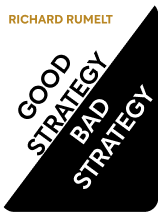

This article is an excerpt from the Shortform book guide to "Good Strategy Bad Strategy" by Richard Rumelt. Shortform has the world's best summaries and analyses of books you should be reading.
Like this article? Sign up for a free trial here .
What makes a good business strategy design? What elements should you take into account when designing a big-picture strategy for a business enterprise?
A good strategy is a well-integrated, tight design made up of parts (divisions, resources, initiatives, and so on) working together to form a coherent whole. Good performance is the result of a clever business strategy design efficiently harnessing an organization’s resources and capabilities to produce a competitive advantage.
Read more about business strategy design from a holistic perspective and consider the consequences of a lack of a well-put-together strategy on a real-world example.
Understanding Business Strategy Design
Think of business strategy design as building a car: While any collection of car parts can be pieced together to form a drivable vehicle, a recognizably branded car is more than simply the sum of its parts. Its pieces are purposefully chosen to carry out a specific design, just as the pieces of a strategy should work together to achieve a specific objective.
According to Richard P. Rumelt, the author of Good Strategy, Bad Strategy, a business strategy must be designed with two points of view in mind: your customer and your competitor. You must design the strategy not only with the preferences of your customer in mind but also with the capabilities of your competitor accounted for so that you can offer something that capitalizes on your strengths in relation to theirs.
Then, in the same way, that designs need to be continually tweaked to ensure that all parts are working together properly and that the overall vision offers something unique, strategy must also be treated as a constantly evolving design. So, just as a car design is not finished until the engineers ensure that the steering, suspension, and electrical controls all interact smoothly, and that they all support the chosen body design and trimmings, a strategy design is not complete until each of its policies is fully coordinated with the others, and constantly adjusted as conditions change.
Designs Have Trade-Offs
Achieving such coordination can be difficult. The many interactions between various parts of a design create a series of “trade-offs,” or compromises. When you optimize one interaction, others are altered, and this can create problems in other areas.
For example, engineers designing a spacecraft might reduce the size of a power unit to meet overall weight restrictions. That might cause the radio to have less power, which means the engineers must increase the accuracy of the receiving dish, which in turn means they’ll need better sensors, which in turn means they’ll need more fuel for altitude control. Each choice to optimize one interaction creates restrictions for others.
The greater the challenge facing an organization, the greater its need for clever strategy design. And while highly integrated design—with tightly coordinated initiatives linking departments, divisions, and resources—is the best way to manage highly complex situations, it may not be the right choice for every situation. In the face of lesser challenges, a less-highly-integrated design may be preferable.
This is because there are costs to highly efficient designs. A highly integrated design is harder to develop, takes more supervision to implement, and is less flexible to change. For example, a race car has a much higher degree of design integration than does a Honda CRV, but the race car is not appropriate for as many purposes as is the Honda. In the same way, a corporate strategy that involves tight coordination between many different departments will require, for example, employees to manage that coordination and may not be worth the extra labor expense if the challenges facing the company aren’t daunting.
Further, if a company has plenty of resources and capabilities, and few restrictions, they will have less of a need for a tightly integrated design. For example, in the example above, if the engineers had a more efficient radio power supply in the first place, or had less-tight weight restrictions, they wouldn’t need to optimize each of the other pieces of the design so precisely.
Consider the specific needs of your organization when you design its strategy so you can meet its needs with the appropriate amount of complexity. However, keep in mind that ultimately, you should have a design of some complexity; having no design can suit a company in the short-run but can lead to complacency (and ultimately, failure) in the long-run. The trajectory of Xerox, explored below, illustrates this problem.
Case Study: Xerox
Xerox provides an excellent example of the way a lack of design, born from a company’s strong resource base, can lead to complacency and ultimately failure.
Because of its rock-solid patents, Xerox dominated the market for photocopiers for decades in the second half of the twentieth century. Because it had virtually no competition, it didn’t need a clever or innovative design behind its strategy: It simply made expensive photocopiers and supported their maintenance with an army of expensive repair people. Its strong resource position—those patents—allowed it to be successful without ongoing strategy management. Consequently, it didn’t prepare for “next steps.” It was, therefore, poorly positioned to meet competition when it did arise (as competition inevitably will) from Canon, Kodak, and IBM.
Xerox fell prey to the faulty thinking behind many resource-rich organizations, which fail to recognize that their ongoing success is a product of long-ago investment, but that these harvests eventually run out. This faulty thinking fells many mature companies. Younger companies invading a marketspace are more likely to have design-based strategies to make up for what they lack in resources, and ultimately succeed because of it.
Of course, the natural life cycles of maturing companies mean that many of these upstarts will eventually also come to rely on leftover success from earlier clever design, and will eventually become vulnerable to a new generation of upstarts. For example, though Bill Gates bested IBM in the 1980s, today Microsoft is a mature company reaping the benefits of past accomplishments just as IBM once did.

———End of Preview———
Like what you just read? Read the rest of the world's best book summary and analysis of Richard Rumelt's "Good Strategy Bad Strategy" at Shortform .
Here's what you'll find in our full Good Strategy Bad Strategy summary :
- The essential components of good strategy and the faulty thinking behind bad strategy
- Specific and measurable techniques for designing a focused strategy for success
- How to overcome challenges and gain a competitive edge






